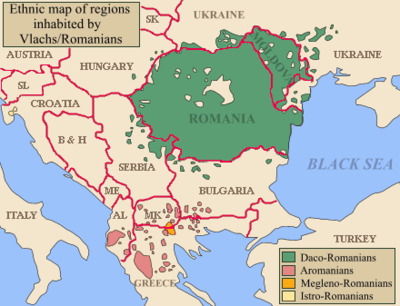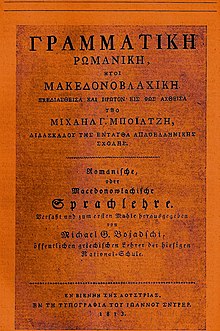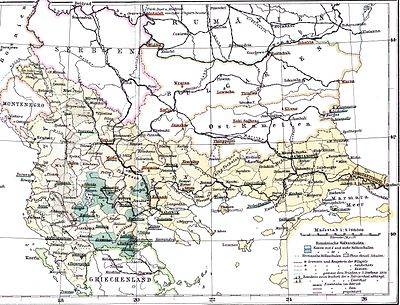Aromanian language
| Aromanian ( armãneashce ) | ||
|---|---|---|
|
Spoken in |
|
|
| speaker | 500,740 (1999) | |
| Linguistic classification |
|
|
| Official status | ||
| Official language in |
|
|
| Language codes | ||
| ISO 639 -1 |
- |
|
| ISO 639 -2 |
rup |
|
| ISO 639-3 |
rup |
|

The Aromanian (also Makedoromanisch , proper name armãneashce or limba armâneascâ ) is that of Vlachs in the southern Balkans spoken Romance language . It is written in the Latin or Greek alphabet , depending on the country , a standardized spelling with the Latin alphabet has now established itself.
The ISO-639 code for Aromanian is rup.
Classification and language name

The Aromanian can be just like the Romanian , Meglenorumänische and Istrorumänische the Urrumänische or proto Romanian attributed, in turn, from the Vulgar Latin had arisen Southeast Europe. Together with these three languages, it forms the Balkan Romance group in the narrower sense within the Romance languages .
Different views were put forward on the status of Aromanian. Some of the linguists consider the four idioms that emerged from Ur Romanian to be dialects of a single Romanian language due to their common origin and linguistic structural similarity. This view is still held by some linguists today. In more recent Romance studies, these four language forms are classified as separate languages, primarily because of their long-standing sociolinguistic independence, so that Aromanian is a separate Romance language in this view ( G. Giuglea , Al. Graur , I. Coteanu ). This thesis is also preferred by the Aromanians, who gather in various centers ( Freiburg , Paris , Constanța , etc.). The intention behind this is to preserve this language.
As a language name, in addition to the Aromanian, which goes back to its own name, some linguists also use Macedorumanian .
In other language sources and partly in older linguistics, Aromanian is also called Wallachian , Wlachian or Vlachian , which goes back to the foreign designation of the neighboring peoples for the Balkan Romans ( Wallachians ) and was also applied to the other Balkan Romance languages.
Distribution and Sociolinguistic Status
Aromanian is the one of the Balkan Romance languages south of the Danube with the largest number of speakers. The distribution area of the Aromanian extends over large parts of the Balkan Peninsula and includes parts of Greece ( Epirus , Thessaly , Macedonia ), Albania, North Macedonia, Bulgaria and Serbia . Due to emigration in the first half of the 20th century, a large number of Aromanians also live in Romania.
The current number of speakers in the individual countries is:
- Greece: 200,000 speakers (according to estimates by the Greek government in 1995)
- Albania: 45,000 speakers (in 1995), dispersed in the southern half of the country
- Romania: 27,000 speakers (2002 census), 75% of them in North Dobruja
- North Macedonia: 8,467 speakers (in 1994)
- Bulgaria: 4,770 speakers (in 2000 according to WCD)
However, even where official data were collected through appropriate surveys or collections of signatures, this information is not necessarily reliable (for example, in 1994 in the Republic of Macedonia only 8,467 people declared themselves to be Aromanians, while the actual number of speakers of Aromanian is estimated to be twice that).
The core of the Aromanian settlement area is today in the Pindus Mountains in northwestern Greece around the city of Métsovon .
In general, the Aromanians find it difficult to preserve their language as there are no schools teaching this language. Only in North Macedonia (8,467 speakers, according to the 1994 census) are they recognized as a minority. In Romania some of the so-called Aromanians call themselves Romanians. The number of speakers is decreasing.
There are still around 200,000 speakers in Greece today (according to an estimate by the Greek government in 1995). The Aromanian language is not recognized as a minority language there. Political advocacy for this language has long been made difficult by legal proceedings. In the 1980s, a group of German linguists who were recording an Aromanian language atlas in Greece were harassed by the Greek police.
A larger group of Aromanian speakers, probably on the order of 50,000 (TJ Winnifrith, in 1995), live in Albania. In the 2011 census, 3848 people gave Aromanian as their mother tongue, which makes 0.137 percent of the total population.
Aromanian is also spoken in other European countries, however, as well as in Canada , the USA , Latin America and Australia , where the Aromanians arrived in different stages and have formed closed communities to this day. Their real total is difficult to determine because there is insufficient research on this aspect.
In 1997 the Council of Europe recognized Aromanian as a "minority language worth protecting".
history
After the Slavs conquered the Balkans , the remnants of the Roman provincial population led a shadowy existence and operated remote grazing , rarely transhumance . The Aromanians emerged from these remains. It is unclear whether the Aromanians are descendants of the Sermesianoi , Roman provincial population who were abducted by the Avars in 616 and settled in Pannonia . This is supported by the fact that the Sermesianoi under the proto-Bulgarian Khan Kuver settled around Thessaloniki after their successful uprising , not far from the current settlement areas of the Aromanians.
Around 1900 the Romanian state tried to set up and promote an Aromanian school system in various Balkan countries, which, however, was strongly Romanian. In the meantime there were 120 such schools. Aromanian contains many elements of Greek , as well as some Romanian elements from the time of the Romanian-sponsored schools.
Between the two world wars, a considerable number of Aromanians settled in Romania, particularly in Dobruja .
Syntax and morphology
The noun distinguishes three genera in Aromanian , masculine, feminine and neuter. Like Romanian, Aromanian has five cases. The definite article appears as a suffix at the end of the noun. Both the definite and the indefinite article are declined.
The verbs in Aromanian do not have an infinitive. In dictionaries they are usually listed in the 1st person singular present indicative. In contrast to other Balkan Romance languages, Aromanian has also received the past tense and the present perfect tense . The future is formed with an auxiliary verb that arose from the verb to want ( va ) and which does not change according to person or number: va s-cântamu , va s-cântațâ (we will sing, you will sing; in Romanian: vom cânta, veți cânta ).
Text example, text comparison
| Aromatic | Romanian | Latin |
|---|---|---|
|
Afendi a nostu tsi eshtsa tu tseru, |
Tatăl nostru care ești în ceruri, |
Pater noster, qui es in caelis |
Note on the Romanian text: In other versions, words such as: fie are replaced by facă-se ; greșelile through greșalele ; mântuiește by izbăvește ; Că a Ta este împărăția și puterea și mărirea, acum și pururea și în vecii vecilor. by Că a Ta este împărăția și puterea și slava, a Tătălui și a Fiului și a Sfântului Duh, acum și pururea și în vecii vecilor.
literature
- The four-language dictionary by Theodoros Anastasiu Kavalliotis from Moschopolis , printed in Venice in 1770, "Albanian-German-New Greek-Aromanian". Updated new edition by Armin Hetzer: The trilingual dictionary of Theodorus Anastasiu Kavalliotis from Moschopolis, printed in Venice in 1770. Albanian-German-Modern Greek-Aromanian . Buske, Hamburg 1998, ISBN 978-3-87118-466-6 .
- Michael George Bojadschi : Gramatiki romaniki itoi macedonovlaki. Romance or Macedonovlachian language teaching , written and edited for the first time by Michael G. Bojadschi, Vienna 1813 (231 pages) (German and Greek); 2nd edition, Bucharest 1863; Gramaticã românã sau macedo-românã , Bucharest 1915; [Excerpt from Greek and German] Romansh or Macedonovlachian language teaching. Grammatike romanike etoi makedonoblachike, in: Aromunische Studien , Salzburg 1981 (Studies on Romanian Language and Literature 5); Gramaticā aromānā icā macedonovlahā , ed. by VG Barba, Freiburg im Breisgau 1988, excerpt from the Aromanian grammar from 1988
- Maria Bara, Thede Kahl, Andrej Sobolev: Южноарумынский говор села Турья (Пинд). Синтаксис, лексика, этнолингвистика, тексты [The South Aromanian dialect of Turia (Pindus)]. Biblion, Munich 2005. ISBN 3-932331-59-1 .
- Mariana Bara: Le lexique latin hérité en aroumain dans une perspective romane . Lincom, Munich 2004, 231 p .; ISBN 978-3-89586-980-8 .
- Mariana Bara: Limba Armâneasca. Vocabularul și style . Editura Cartea Universitară, Bucharest 2007, 204 p .; ISBN 978-973-731-551-9 .
- Theodor Capidan: Aromânii. Dialectul aromân. Bucharest 1932.
- Gheorghe Carageani: Studii aromâne. Bucharest 1999.
- Matilda Caragiu Marioțeanu: Dicționar aromân (macedo-vlah). T. 1 (A-D). Bucharest 1997.
- Wolfgang Dahmen , Johannes Kramer : Aromanian Language Atlas - Atlasul lingvistic aromân. 2 volumes. Hamburg 1985, Veitshöchheim 1994 ( Balkan Archive. New series , supplements 4 and 10).
- Thede Kahl: Open questions in the study of Aromanian and its dialects. In: Sobolev, Andrej N. & A. Ju. Rusakov: Языки и диалекты малых этнических групп на Балканах [languages and dialects of small ethnic groups in the Balkans]. Материалы междунарой научной конференции, Санкт-Петербург, 11-12 июня 2004 г. Санкт-Петербург / Munich, pp. 156–167.
- Thede Kahl: Language and intention of the first Aromanian text documents, 1731–1809. In: Bernhard Symanzik (Ed.): Festschrift for Gerhard Birkfellner on the occasion of his 65th birthday , Studia Philologica Slavica I / I, Munster texts on Slavistics, pp. 245–266 2006.
- Johannes Kramer: The Aromanian . In: Günter Holtus, Edgar Radtke (Hrsg.): Romanian Studies in Discussion. Language, literature and history . Gunter Narr, Tübingen 1986, pp. 217-247.
- Johannes Kramer: Area Linguistics II. Aromanian. In: Holtus G., Metzeltin M., Schmitt Chr. (Ed.): Lexicon of Romance Linguistics . Tübingen 1989. pp. 423-435.
- Elena Mantu: Language Maintenance and Functional Expansion of Lesser-Used Languages- Case Studies on Aromanian and Irish | Balkans | Ethnic Groups . In: SCRIBD. Albert-Ludwigs-Universität Freiburg i.Br., June 14, 2007, accessed on June 27, 2019 (English).
- Tache Papahagi: Dicționarul dialectului aromân. General și etimologic . Ed. Academiei Republicii Populare Române, Bucharest 1963 (2nd edition 1974).
- Rupprecht Rohr : Aromanian etymological word studies. Vol. 1: AD . Haag + Herchen, Frankfurt am Main 2002.
- Rainer Schlösser: Bibliography on Aromanian . In: Balkan Archives . New episode 4. Leipzig 1979.
- Gustav Weigand : Folk literature of the Aromanians. Leipzig 1894.
- Weigand, Gustav: The language of the Olympo-Wallachians with an introduction to the country and its people. Leipzig 1888.
- Apostol N. Caciuperi: Noulu testamentu , Traduteri dit literatura româna si universala , Gramatica armâneasca - proiectu di manual scolar , Cursu practic di graiu armânescu . In: Apostol N. Caciuperi (ed.): Opere . 4 volumes. Universalia, Bucharest 2011.
- Apostol N. Caciuperi: Dictionar român-aromân . Atlas, Bucharest 1996.
Web links
- Macedon Armans Council (English)
- Macedon Armans Association from France (English)
- Consiliul A Tinirlor Armanj, webpage about Youth Aromanians and their projects (English)
- Ethnologue (English)
- Settlements in which Aromanians at the beginning of the XX. Century lived (map)
Individual evidence
- ↑ Aromanian at Ethnologue (English)
- ↑ Article from Encyclopaedia Britannica on the Romanian language (English)
- ↑ Census Albania 2011. (PDF; 6.5 MB) (No longer available online.) In: Instituti i Statistics . Archived from the original on November 14, 2014 ; accessed on November 2, 2013 .

